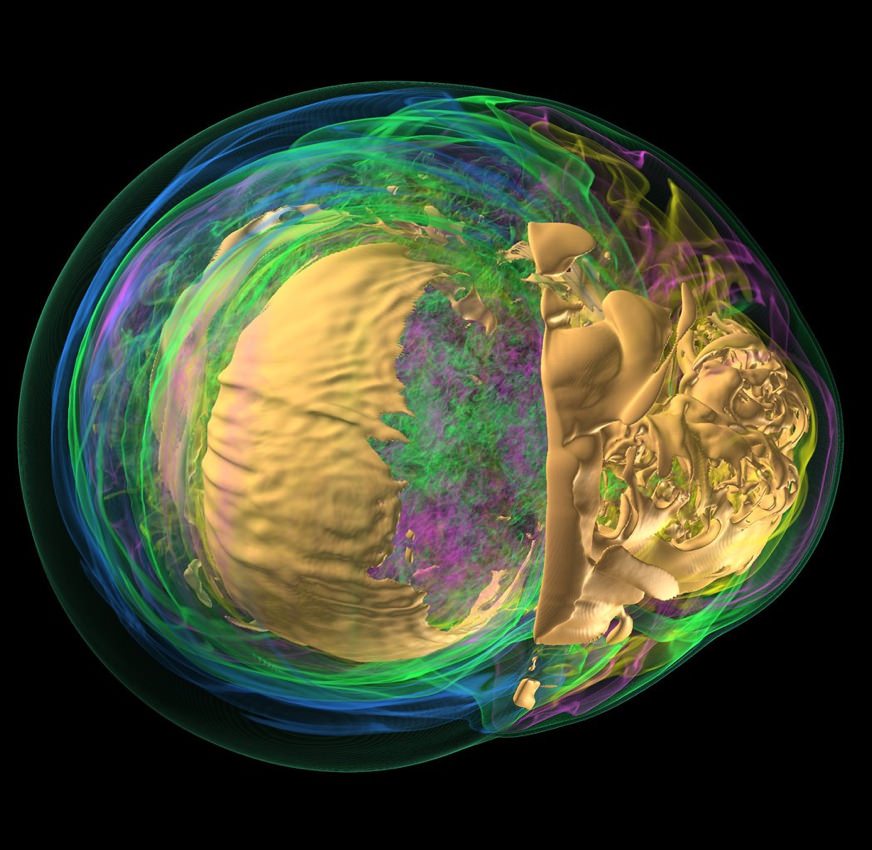Here’s this week’s image for the WITU Challenge, to test your visual knowledge of the cosmos. Take a look at this image and see if you can determine where in the universe this image is from. This one is a little different, but several readers sent it in, suggesting we use it. We’ll provide the image today, but won’t reveal the answer until tomorrow. This gives you a chance to mull over the image and provide your answer/guess in the comment section. Please, no links or extensive explanations of what you think this is — give everyone the chance to guess.
UPDATE: The answer has now been posted below.
This is a model of an exploding star’s core created by the U.S. Department of Energy’s Argonne National Laboratory developed to help show what happens inside core-collapse supernovae. The model was made using the lab’s IBM Blue Gene/P machine, currently ranked seventh on a list of the world’s most powerful supercomputers. Argonne’s Blue Gene/P boasts more than 160,000 processors, as many as would be found in Giants Stadium were it filled to capacity with people toting dual-core laptops.
To find out more about this images see this article in Scientific American.


Computer modeling of a super nova. (Argonne National Laboratory)
Supernova simulation in a supercomputer. I hope it’s as cientifically relevant as it is absolutely gorgeous.
Anyway, since the question is “where in the universe”, I’d have to say “Earth”. This thing is an artifact of earthling technology. 😉
That was the Big Picture on BBC News the other day. Too easy (i.e. even *I* got it).
Looks like a supercomputer sim of a supernova. Don’t know the lab, though.
Agree with computer model, but… looks more like an asteroid smashing into the Earth.
The embryonic stage of a sci-fi alien. Or Betelgeuse real soon; star age speaking.
So much eye candy on UT today, this tops it all!
Looks very asymmetric for a supernova, but since it seems to be one, that’s good news: lots of gravitational waves in this case.
Its Spocks Brain, or a supercomputer simulation of a low mass star at the end of its life.
Sheese! I’m one who sent this in. I didn’t think anybody would get it! Yawl are soooo smart!
I came in here to say supernova simulation via a supercomputer as well (I don’t know which one). I distinctly remember the asymmetry as Manu mentioned, and it was probably even right here on Universe Today.
This looks like an MRI image of the interior of an egg. I can’t say what species, or whether reptile or bird.
LC
Argonne National Laboratory in Chicago computer simulation of supernova.
Snapshot of a computer simulation of a Supernova type Ia explosion using Argonne supercomputer
Different colours and transparencies are assigned to different values of entropy.
By selectively adjusting the colour and transparency, the scientists can peel away the outer layers and see what is happening in the interior of the star.
(Image Credit: Hongfeng Yu)
I retract my suggestion. This is a SN aI simlulated at Argonne NL.
LC
ROCA: it’s a core-collapse type simulation. Not a 1a type.
whatever type simulation this is, looks like an eyeball to us.
ROCA, and of course you know all that from the top of your head, down to the name of the guy who should be credited for the image, don’t you?
😉
Anatomy of an alien eye,
Where: ARGONNE, Ill
What: Entropy values in the core of the supernova
Maybe New Scientist is wrong, too…
Cool image, but it is interesting to notice the asymmetry in the result of the simulation.
Do we see any asymmetry in anything when we observe supernova?
ROCA: I prefer the original source, less chance of misinterpretation. So if New Scientist says it’s a type 1a, then they’re wrong.
GekkoNZ: go see the wikipedia article on supernovae. It tells all about asymmetric supernova explosions.
It seems that this supernova simulation was run at Argonne National Lab in Batavia, IL using a new type of GPU-CPU processing code on their Blue Gene/P supercomputer comprising 160,000 computer cores all working in parallel mode! Story, links, and credits can be found in this 7-30-09 press release: http://www.anl.gov/Media_Center/News/2009/news090730.html . What a great announcement about the capability to model SNe in real time AND in 3-D !!